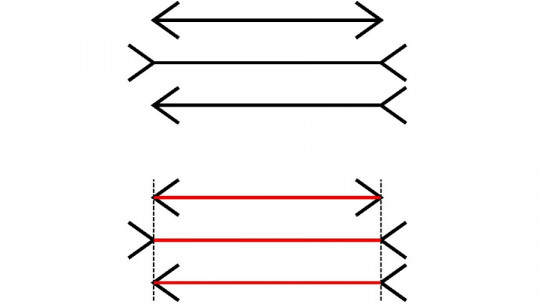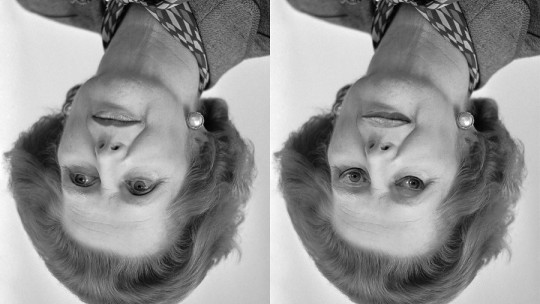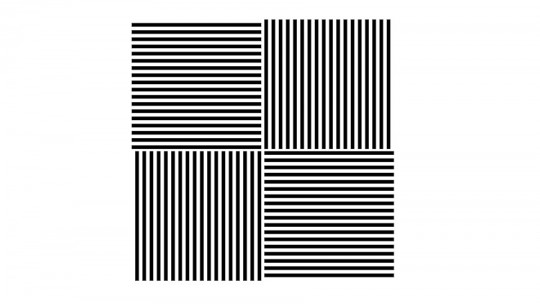
Optical illusions trick our visual perception system, making us believe that we see a reality that is not what it seems.
The Müller-Lyer illusion is one of the most well-known and studied optical illusions, and has allowed scientists to test numerous hypotheses about the functioning of human perception.
In this article we explain what is the Müller-Lyer illusion and what are the main theories that try to explain its operation.
What is the Müller-Lyer illusion?
The Müller-Lyer illusion is one of the best known geometric optical illusions which consists of a set of lines ending in arrowheads. The orientation of the tips of each arrow determines how we accurately perceive the length of the lines.
As with most visual and perceptual illusions, the Müller-Lyer illusion has allowed neuroscientists to study the functioning of the brain and the visual system, as well as the way in which we perceive and interpret images and visual stimuli.
This optical illusion It is named in honor of the German psychiatrist and sociologist, Franz Carl Müller-Lyer who published up to 15 versions of this illusion in a well-known German magazine, at the end of the 19th century.
One of the best-known versions is the one that consists of two parallel lines: one of them ends in arrows that point inward; and the other ends with arrows pointing outwards. When looking at the two lines, the one containing the arrows pointing inward appears significantly longer than the other.
In other alternative versions of the Müller-Lyer illusion, each arrow is placed at the end of a single line, and the observer tends to perceive the midpoint of the line just to make sure the arrows stay constantly on one side of it.
Explanation of this phenomenon of perception
Although it is still not known exactly what causes the Müller-Lyer illusion, various authors have provided different theories, the most popular being perspective theory.
In the three-dimensional world, We often tend to use angles to estimate depth and distance. Our brain is accustomed to perceiving these angles as closer or farther corners, at a greater or lesser distance; and this information is also used to make judgments about size.
Perceiving the arrows in the Müller-Lyer illusion, the brain interprets them as far and near corners canceling out the information from the retina that tells us that both lines are the same length.
This explanation was supported by a study that compared the response to this optical illusion in children in the United States, and in children in Zambia who came from urban and rural areas. Americans, more exposed to rectangular structures, were more susceptible to the optical illusion; followed by urban Zambian children; and, finally, of Zambian children in rural areas (less exposed to these types of structures due to living in natural environments).
However, it seems the Müller-Lyer illusion also persists when arrows are replaced by circles which have no relation to perspective or the theory of angles and corners, which seems to call into question the theory of perspective.
Another theory that has tried to explain this perceptual illusion is the theory of saccadic eye movements (rapid eye movements when moving to extract visual information), which states that we perceive a longer line because we need more saccades to see a line with arrows pointing inward compared to the line with arrows pointing outward.
However, this last explanation seems to have little basis, since the illusion seems to persist when there is no saccadic eye movement.
What happens in our brain in optical illusions?
We have known for a long time that Our brain does not perceive reality as it is, but rather tends to interpret it in its own way, filling in the missing gaps and generating hypotheses and patterns that allow us to give coherence and meaning to what we see. Our brain resorts to cognitive and perceptual shortcuts to save time and resources.
Optical illusions, such as the Müller-Lyer illusion, generate doubts in our perceptual system, and by not finding a known and congruent pattern, the brain decides to reinterpret what it sees (in this case, the arrows and lines) through your storehouse of previous experiences and statistics; and after having extracted the available information, you come to a conclusion: the lines with the arrows pointing out are longer. An erroneous but coherent conclusion.
On the one hand, from a physiological point of view, optical illusions (the most frequent, ahead of auditory, tactile and gustatory-olfactory illusions) can be explained as a phenomenon of light refraction, like when we put a pencil in a glass of water and it, apparently, twists.
These illusions can also be explained as a perspective effect, in which the observer is forced to use a certain pre-established point of view, as occurs with anamorphoses, deformed drawings that recover their image without deformations when viewed from a certain angle or cylindrical mirror. In a similar way, certain contrasts between colors and shades, in combination with eye movement, can generate illusions of false sensation of movement.
On the other hand, from the point of view of the psychology of perception (or Gestalt psychology), an attempt has been made to explain that we perceive the information that comes to us from the outside, not as isolated data, but as packages of different elements. in significant contexts, according to some rules of interpretive coherence. For example, we tend to group together elements that are similar, and we also tend to interpret multiple elements moving in the same direction as a single element.
In short, what we have learned over the years, thanks to the work of researchers and neuroscientists with optical illusions like Müller-Lyer, is to distrust what our eyes see, since many times our brain deceives us, perceiving what is real but does not exist. Paraphrasing the French psychologist, Alfred Binet: “Experience and reasoning prove to us that in all perception there is work.”








